#non-Turkic
Text

Portrait of Poetess and Ethno Singer Nadezhda Varlamova.
Портрет поэтессы и этно-певицы Надежды Варламовой
Oil on canvas. холст, масло Mira Argunova. (Мира Аргунова.)
#non-russian#indigenous russia#indigenous russian#siberian people#sakha#Sackha#Саха#Yakutia#Якутия#Sackha culture#Культура Саха#turkic
69 notes
·
View notes
Text
Hi fucking reminder to my Turks and Azeris that if you don't fucking support Armenians then block me. If you support the genocide and blockage of Artsakh then block me. If you support the war uprising again then fucking block me. Listen to fucking Armenians and stop falling for the Azeri propaganda. Fuck the Azeri government.
7 notes
·
View notes
Text

🐣 Did you know? that, by tradition, not visiting families (and thus not participating in mrskut) on Easter Monday can be considered a great offence to the family?
And if you come late, even a minute late after noon, expect a very cold shower from a vengeful lass. 🐣
Happy Easter (Monday)!!!
Tagging @noldorinpainter cuz 🤲💖 ngl it's us 🤣🤣🤣!!!
Refs/color palettes: 🇨🇿, 🇹🇷
#and here i am with my yearly easter monday czech/moravian traditions trivia 🤲🐣#the turkish gal was a mere visitor and wasn't pushed into the celebrations against her will 😅 i promise 🐣 tho if she wanted... 😅#also simplified embroidery and other stuff on both gals 😔 forgive me 🌼#non-arda stuff#easter#easter monday#slavic culture#turkic culture#moravian culture#hanakian culture#hanakian traditional clothing#central turkish traditional clothing#art#my art#joli's art#traditional art#digital art
17 notes
·
View notes
Text
actually Islamic history (esp between 700-1300's) is super interesting to me
#but i like to learn about non arabic peoples takes and customs about islam#like turkic people and others... especially its spread on anatolia#and mamluks
4 notes
·
View notes
Text
The way people don’t understand genetics history or geography is so apparent when people on Twitter bicker about whether southern and or eastern Europeans are white
#not only is pan Mediterranean travel a thing and has been since ppl could build ships#(north africa is literally actoss this sea y’all)#there are non white indigenous peoples . there’s roma and romani#there’s mongol and turkic genes and all sorts of occupations back n forth#reality is not so simple#the oppression of balkan ppl will never be the same as the oppression of black slaves in the usa. of course.#italians can be white . but there have always been african south Europeans and asian east europeans#I personally know of a black family in montenegro that’s been there for centuries#most people in the balkans have turkish arabic and or mongol genes somewhere in the family tree. many r muslim#it’s complicated#and yea I’m sure they benefit more from colonialism and white supremacy than actual asians and africans 100% that is true#but to dumb it down to ‘they r white’ is a bit ignorant considering ie. serbs were literally targeted by the nazis for being serbs#many balkan states were considered “’contaminated’ by eugenicists bc they didn’t look germanic
19 notes
·
View notes
Photo
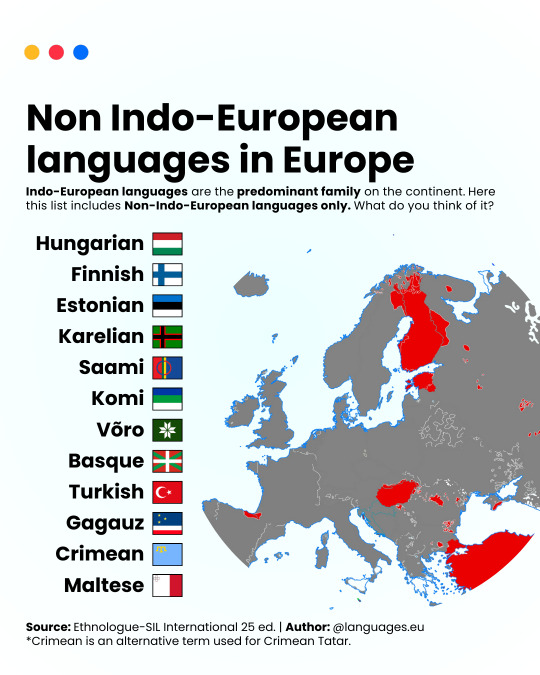
Non Indo-European languages in Europe
Of the approximately 45 million Europeans speaking non-Indo-European languages, most speak languages within either the Uralic or Turkic families. Still smaller groups — such as Basque (language isolate), Semitic languages (Maltese, c. 0.5 million), and various languages of the Caucasus — account for less than 1% of the European population among them. Komi Republic is not located necessarily in Europe, the language is spoken in Nurmansk as well. Therefore, it appears in the list! This list mostly highlights the majority languages. Most of other Non-Indo-European languages are extinct or almost extinct in Europe.
by languages.eu
459 notes
·
View notes
Text
Me: I don’t deny your identity. I acknowledge Palestinians exist today.
Them: Jesus was a Palestinian, not a Jew!
Me: Well, no - he was a Jewish rabbi. He had a bris, kept Shabbat, kept kosher, & his “Last Supper” was a Passover Seder. Besides, nobody would be called “Palestinian” for ~1,900 years after #Jesus died.
Them: Jews are #Khazars with no history in Palestine!
Me: Well, no - millions of DNA samples have now scientifically proven that Ashkenazi Jews (like their Sephardi & Mizrahi brothers & sisters) originate from the Levant (Israel).
Ashkenazi Jews migrated to the Rhineland (western #Germany) between 800-900 CE.
#Yiddish - the language spoken by #Ashkenazi Jews for a millennia - is a mixture of Jews’ original Hebrew & adopted #German.
Meanwhile, there is no evidence of any Khazar influence on Ashkenazi customs, language, or culture.
The #Khazar tale (claiming some or many Turkic Khazars converted to #Judaism), while interesting, is not supported by any archeological evidence, and can be considered nothing more than a story.
Besides, it’s unassailable that the Ashkenazim were living ~1,500 miles from the Khazars, which may as well have been on the moon in the Middle Ages.
Them: Palestinians are Canaanites, the original inhabitants of the Land!
Me: Well, no - there’s zero evidence the Palestinians are Canaanites. This theory followed other similarly false claims over the past several decades that the Palestinians descend from the Philistines (an ancient Aegean Greek “sea people”) and even the Jebusites - a people for whom there is no evidence outside of the Bible of their having ever existed (if they did, they have been gone for at least 3,000 years).
One thing is clear, all of these recent tall tales about Palestinians’ ancient roots in “Palestine” were created in an attempt to delegitimize the State of Israel & not as some academic attempt to find Palestinian roots.
The #Canaanites (who spoke a language similar to #Hebrew, not #Arabic) have been extinct for more than 3,000 years; and there are no #Canaanite influences in any modern Palestinian language, culture, cuisine, customs, or religion.
Furthermore, DNA studies now prove Canaanites are closest in descension to modern-day Armenians & Western Iranians - but, culturally, there has not been a “Canaanite” people in ~3,000 years.
Meanwhile, there is a practically infinite amount of archeological, biblical & non-biblical text, and architectural evidence proving beyond any doubt that Jews lived in the Land of Israel continuously for more than 3,200 years.
Arabs only started arriving in Eretz Israel in significant numbers during the Arab Imperial conquest out of the deserts of the Arabian Peninsula in the mid 7th century CE when the Land was still majority-occupied by ~350,000 Jews.
Arab conquerers #colonized the Land of Israel & subjugated the Jewish majority.
That’s right, the Arabs were the #colonizers - this is historical fact no matter how much that might make your head hurt.
Them: The Jews are foreigners who stole Palestinian land!
Me: Ok, now you’ve officially ticked me off by repeatedly denying MY identity - one that was OBVIOUS to everyone before the last ~55 years when KGB-inspired propaganda went into mass effect in an effort to delegitimize Israel.
Can’t say the same about your identity … even though I keep trying to offer to respect it!
The Arabs only ruled Eretz Israel after conquering it in the 7th century & until they were kicked out by the Seljuks ~400 years later. Never during that time, did they even attempt to establish an Arab or #Muslim state or capital anywhere in Eretz Israel (Jerusalem is never mentioned in the Koran, and while the city is holy to Sunni Muslims, it is not holy to Shia Muslims).
And during the time of Arab rule, there was obviously no state or country called “Palestine.”
Then, during the 400 years before the start of the British Mandate around 1920, the Land was a distant & severely neglected province of the Ottoman #Turkish Empire.
In fact, in the late 19th century, as Jews began moving back to their homeland in larger numbers, there were only ~200,000 people living there (mostly a sparse, nomadic population), and Jews were the majority in #Jerusalem.
Post-WWI, the League of Nations (the precursor to the UN) legally granted Britain a "sacred trust" called the Mandate for Palestine (a name given to the land by Roman Emperor Hadrian in 135 CE).
The Mandate for Palestine was the least controversial of the 15 post-WWI mandates because everyone KNEW Jews were from “Palestine.”
So the Mandate for Palestine, which included the legal requirement for Britain to aid in the establishment of a Jewish National Home, passed unanimously by the League of Nations.
Among other things, the unanimously passed & legally-binding Mandate recognized “the historical connection of the Jewish people with Palestine and to the grounds for reconstituting their national home in that country.”
Besides, before the Jews started returning to the Land in large numbers in the late 19th century, it had become almost entirely war-torn ruins, arid desert & malarial swamps.
But the returning Jews were determined to rebuild their homeland; and the evidence is undeniable that Jewish labor & the Western technology they brought along helped to make the desert bloom again.
The result of a new booming economy in the midst of mostly rural, undeveloped land is no surprise; and hundreds of thousands of Arabs from neighboring lands immigrated to Mandate Palestine in the early to mid 20th century.
In fact, once Arabs began to rebel against the Jews (with pogroms & full-blown barbaric massacres on a particularly wide scale in 1920, 1921, 1929, and in 1936-1939), they made extremely clear to the British that they resented the name “Palestine,” which they claimed (incorrectly) was a modern Zionist invention.
For example, at the British Peel Commission in 1937 (looking into Arab riots from the year before), local Arab leader Audi Bey Abdul-Hadi testified that “[t]here is no such country [as Palestine]! Palestine is a term the Zionists invented!”
Again, during the 1946 Anglo-American Committee of Inquiry that was set-up to make recommendations for the territory, Arab-American historian Philip Hitti testified, “There is no such thing as Palestine in [Arab] history, absolutely not.”
The Arab position was not particularly surprising, as "Palestine” is not an Arab word (Arabic does not even have a letter “P” or a sound for “P,” which is why you often hear Arabs today pronounce it with a “B” as “Balastine”).
The Arabs in the Land at that time mostly identified with their local clan & otherwise considered themselves “Arabs” of “Southern Syria.”
In fact, just about anyone who was called a “Palestinian” pre-1948 was a #Jew.
This is why nobody made any attempt to create a “Palestinian state” during the 19 years between 1948 and 1967 in which #Egypt occupied #Gaza & #Jordan occupied the “#WestBank.”
The hard truth - even though I’m still acknowledging a #Palestinian people exists today - is that an Arab “Palestinian” identity was created for the first time in any signifiant way at the height of the Cold War in the mid-1960s & at the behest of the #Soviet#KGB, which wanted to expand its influence in the region, undermine the only democracy in the Middle East, and which had been repeatedly embarrassed by Israeli victories over invading Soviet-backed & Soviet-armed Arab states.
So the KGB wrote the ridiculous “Palestine Liberation Organization” (PLO) charter & molded Yasser Arafat at what was known as “KGB U” in #Moscow to use #terror & #propaganda to destabilize Israel.
Over the decades since then, many Arabs in the Land have come to self-identify as “Palestinians.”
Even among Palestinians today, however, many still identify with their clan over a separate “Palestinian” nationality (e.g., the clans do not intermarry & many are constantly engaged in some degree of violent conflict).
And the 2 million+ Arabs citizens of the State of Israel (who have equal protection under the law & more rights & privileges than they would have in any Arab and/or Muslim country on Earth) almost exclusively identify as either #Israeli-#Arabs or as simply #Israelis - not as #Palestinians.
Them: #Jews … I mean #Zionists … are bad, ok? Just ask the UN.
Me: Right. Just ask the #UN
Captain Allen
@CptAllenHistory
595 notes
·
View notes
Text
this is absolutely a conversation that would need a lot of collaboration with Black communities, Black Jews and Black yiddishists but it would be so great to see some Yiddish language content about Black foodways and cooking demonstrations and such. (For more on the topic of Black and Jewish and Black-Jewish foodways please see Michael twitty!) One thing I noticed while writing a letter to a friend describing soul food I’d eaten on a trip was how many words related to these topics differ from standard German or Germanic vocabulary - not hugely a surprise given that the agricultural and natural terminology in Yiddish tend to be where a lot of the Slavic vocabulary is
Disclaimer that what you see below is a mix mainly of the comprehensive modern dictionary, words I’ve heard used in modern non chasidic yiddish communities, Yiddish language books and my own experience and that all of the following is subject to vary esp depending on where the dialect of Yiddish originated
anyway there’s:
נשמה-עסן )neshome-esn (soul food, likely a modern calque from English but it’s sooo great). Hebrew word “neshome” for soul + Germanic “Esn” (food)
מאַסלימקע - maslinke - Slavic - buttermilk
סמעטאַנע- smetane- Slavic - sour cream
פּאַפּשוי - papshoy- Romanian - corn
פּאַפּשויברויט - papshoybroyt- cornbread
אוגערקע - ogurke - Slavic - cucumber
די זויערע אוגערקעס - di zoyere ogurkes (the pickles)
ארבוז (Arbuz- one of many but the word my grandmas family used) - Slavic - watermelon
טשאָלענט - tsholent - probably an old Romance language like old French - the super thick comforting shabbes stew
אָזשענע - ozhene -Slavic - blackberry
באָב - Bob - Slavic - bean
קאַבאַק - kabak- possibly Russian but from a Turkic language - squash
מאַמאַליגע- mamalige - a Romanian type of cornmeal pudding or mush
באַמיע- bamye- okra - from Ottoman Turkish from either Persian or Arabic
חזיר - khazer - pig (from Hebrew)
חזיר-פֿלייש - khazer-Fleish - pork
פּאָנטשקע - pontshke - Slavic - donut
מאכל - maykhl - dish/treat - from Hebrew
מסיבה - mesibe- party - from Hebrew
שימחה - simkheh- party - from Hebrew
סודה - sudeh- feast - from Hebrew
Some other useful/related vocabulary here too:
שמאַלץ - shmaltz - chicken fat - from old German, no idea how this might be used in modern German dialects
משפחה - mishpokhe - family - from Hebrew
קהילה - kehile- from Hebrew - there are a bunch of words for “community” in Yiddish with different nuances, this is one I hear a lot from modern Yiddishists
אבֿות - oves- literally “fathers”, ancestors, from Hebrew
ירושה - yerusheh- inheritance - from Hebrew
ירשענען - yarshenen - to inherit - Hebrew root with German verb structure
34 notes
·
View notes
Text
Pan-Turkism has been characterized by pseudoscientific theories known as Pseudo-Turkology.[64][65] Though dismissed in serious scholarship, scholars promoting such theories, often known as Pseudo-Turkologists,[64] have in recent times emerged among every Turkic nationality.[66][67] A leading light among them is Murad Adzhi, who insists that two hundred thousand years ago, "an advanced people of Turkic blood" were living in the Altai Mountains. These tall and blonde Turks are supposed to have founded the world's first state, Idel-Ural, 35,000 years ago, and to have migrated as far as the Americas.[66]
According to theories like the Turkish History Thesis, promoted by pseudo-scholars, the Turkic peoples are supposed to have migrated from Central Asia to the Middle East in the Neolithic. The Hittites, Sumerians, Babylonians, and ancient Egyptians are here classified as being of Turkic origin.[65][66][67][68] The Kurgan cultures of the early Bronze Age up to more recent times are also typically ascribed to Turkic peoples by pan-Turkic pseudoscholars, such as Ismail Miziev.[69] Non-Turkic peoples typically classified as Turkic, Turkish, Proto-Turkish or Turanian include Huns, Scythians, Sakas, Cimmerians, Medes, Parthians, Pannonian Avars, Caucasian Albanians, and various ethnic minorities in Turkic countries, such as Kurds.[69][70][71][67][68] Adzhi also considers Alans, Goths, Burgundians, Saxons, Alemanni, Angles, Lombards, and many Russians as Turks.[66] Only a few prominent peoples in history, such as Jews, Chinese people, Armenians, Greeks, Persians, and Scandinavians are considered non-Turkic by Adzhi.[66]
Philologist Mirfatyh Zakiev, former Chairman of the Supreme Soviet of the Tatar ASSR, has published hundreds of "scientific" works on the subject, suggesting Turkic origins of the Sumerian, Greek, Icelandic, Etruscan and Minoan languages. Zakiev contends that "proto-Turkish is the starting point of the Indo-European languages".[66] Not only peoples and cultures, but also prominent individuals, such as Saint George, Peter the Great, Mikhail Kutuzov and Fyodor Dostoevsky, are proclaimed to have been "of Turkic origin".[66] As such the Turkic peoples are supposed to have once been the "benevolent conquerors" of the peoples of most of Eurasia, who thus owe them "a huge cultural debt".[66][72]
The pseudoscientific Sun Language Theory states that all human languages are descendants of a proto-Turkic language and was developed by the Turkish president Mustafa Kemal Atatürk during the 1930s.[73] Kairat Zakiryanov considers the Japanese and Kazakhgene pools to be identical.[74] Several Turkish academics (Şevket Koçsoy, Özkan İzgi, Emel Esin) claim that Zhou dynasty were of Turkic origins.[75][76][77][78]
what is going on with the turkish
341 notes
·
View notes
Text
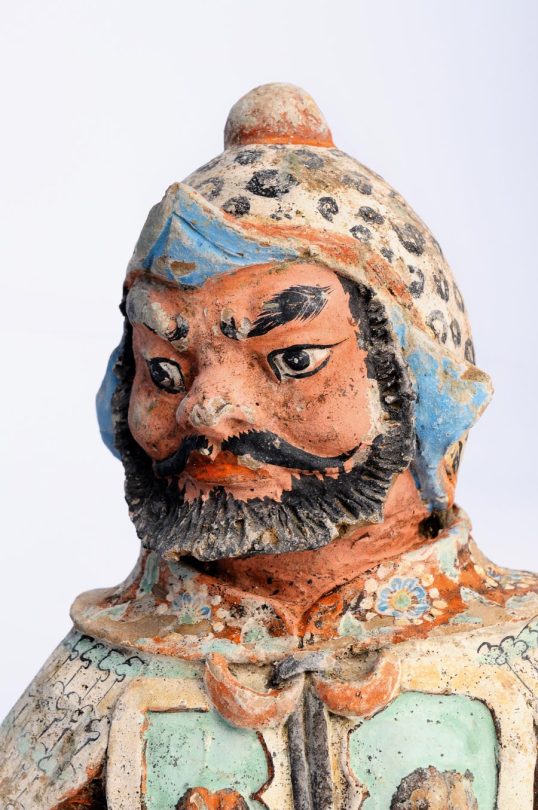
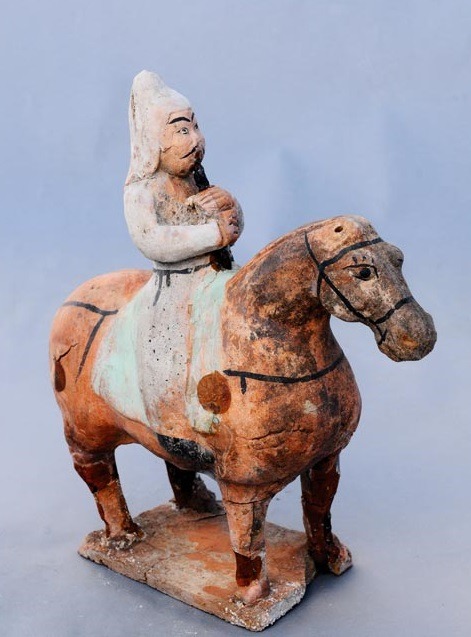

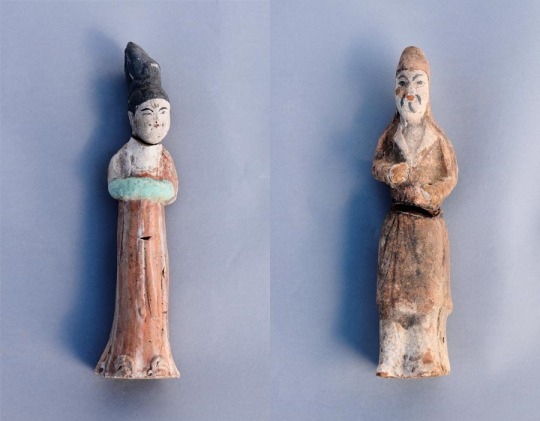


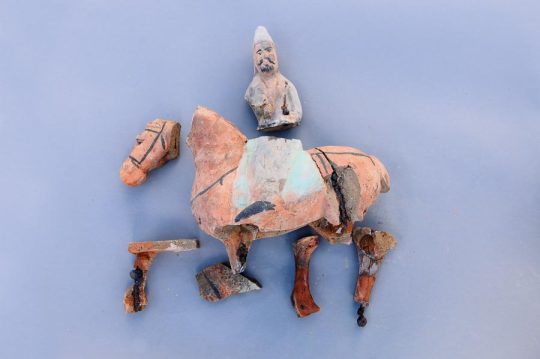
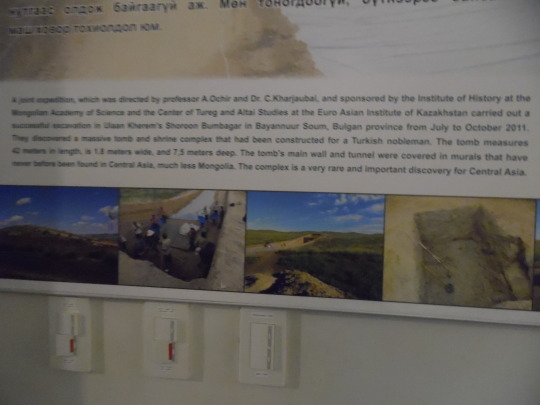




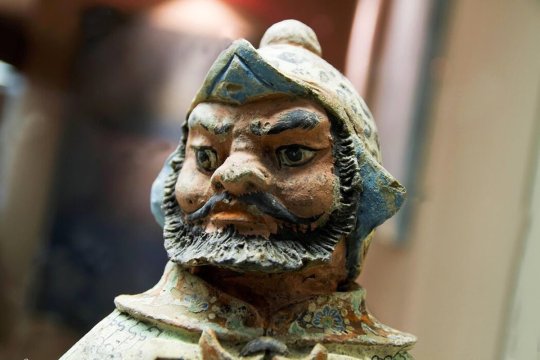
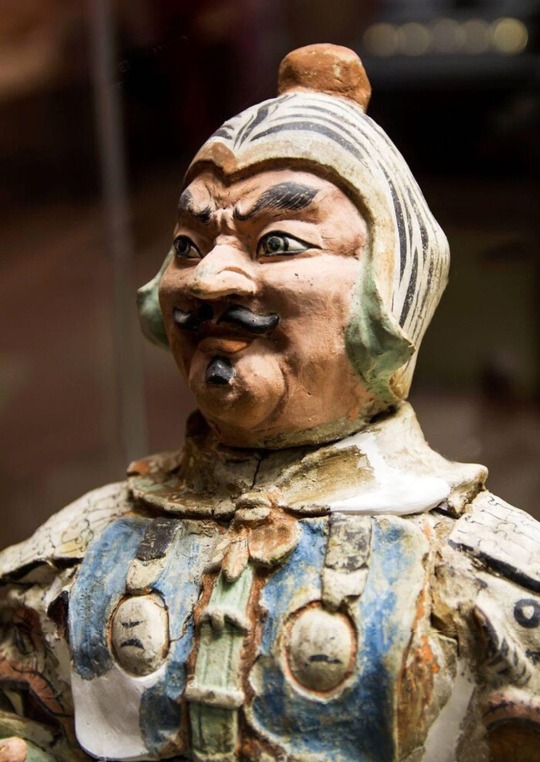
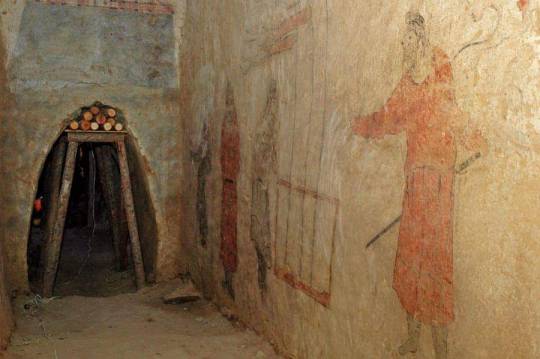

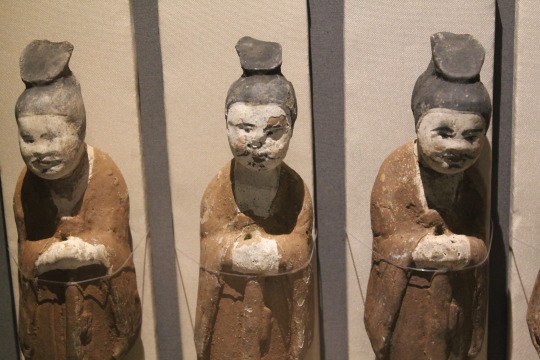

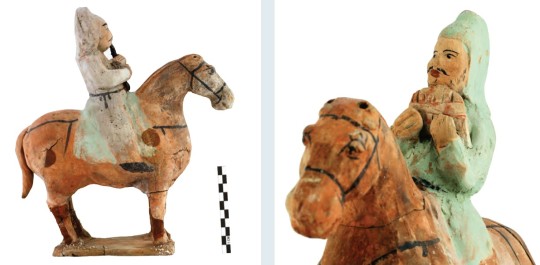

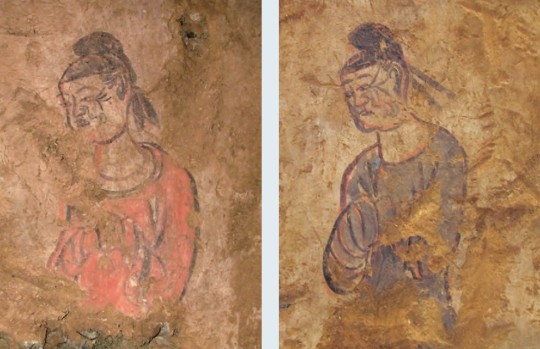


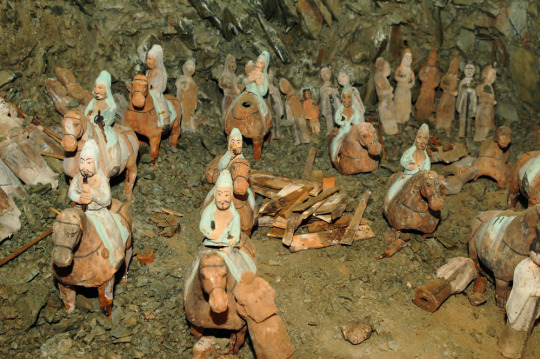





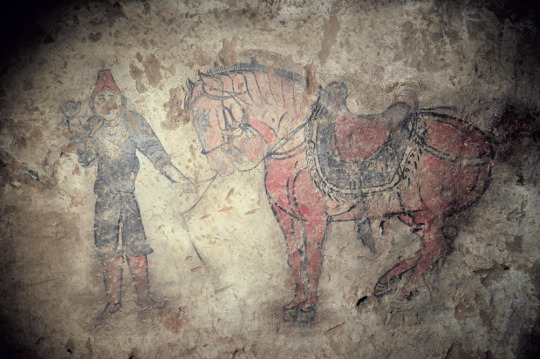
Shoroon Bumbagar, tomb of a Turkic (Gokturk) nobleman, 650-700 CE
"Like Chinese historians, Muslim writers in general depict the ‘Turks’ as possessing East Asian physiognomy. For instance, Sharaf al-Zamān Tāhir Marvazī describes them as being ‘short, with small eyes, nostrils, and mouths’ (1942: 53–4, 156). Similarly, Tabarī (d. 923) depicts the ‘Turks’ as being ‘full-faced with small eyes’ (1987: 21). In his Qābūs-nāma, the eleventh-century Ziyarid ruler Kai Kā'ūs also describes the ‘Turks’ as possessing ‘a large head (sar-i buzurg), a broad face (rūy-i pahn), narrow eyes (chashmhā-i tang), and a flat nose (bīnī-i pakhch), and unpleasing lips and teeth (lab va dandān na nīkū)’ (Kai Kā'ūs ibn Iskandar 1951a: 103; 1951b: 64). The Arab historian and geographer al-Mas'ūdī (896–956) writes that the Oghuz Turks residing in Yengi-kent, a town near the mouth of the Syr Darya, ‘are distinguished from other Turks by their valour, their slanted eyes, and the smallness of their stature’ (wa hum ashadd al-Turk ba’san wa aqsaruhum wa asgharuhum a‘yunan wa fī al-Turk man huwa aqsar min hā’ulā’) (al-Mas'ūdī 1962–: Vol. 1, 212). However, Muslim writers later differentiated the Oghuz Turks from other Turks in terms of physiognomy. Rashīd al-Dīn writes that ‘because of the climate their features gradually changed into those of Tajiks. Since they were not Tajiks, the Tajik peoples called them turkmān, i.e. Turk-like (Turk-mānand)’ (Rashīd al-Dīn Fażlallāh Hamadānī 1988: Vol. 1, 35–6; Rashiduddin Fazlullah 1998–99: Vol. 1, 31). Hāfiz Tanīsh Mīr Muhammad Bukhārī (d. c. 1549) also relates that after the Oghuz came to Transoxiana and Iran, their ‘Turkic face did not re-main as it was’ (1983: fol. 17a (text), Vol. 1, 61 (trans.)). Abū al-Ghāzī Bahadur Khan similarly writes that ‘their chin started to become narrow, their eyes started to become large, their faces started to become small, and their noses started to become big’ after five or six generations (Abu-l-Gazi 1958: 42 (text), 57 (trans.); Ebülgazî Bahadir Han 1975: 57–8). As a matter of fact, the mixed nature of the Ottomans, belonging to the Oghuz Turkic group, is noted by the Ottoman historian Mustafā Ālī (1541–1600). In his Künhü'l-ahbār, he remarks that the Ottoman elites of the sixteenth century were of mostly of non-Turkic origin: ‘Most of the inhabitants of Rum are of confused ethnic origin. Among its notables there are few whose lineage does not go back to a convert to Islam …’ (Ekser-i sükkān-i vilāyet-i Rūm meclis-i muhtelit ul-mefhūm olub ā‘yānında az kimsene bulunur ki nesebi bir müslüm-i cedīde muntehī olmaya) (Fleischer 1986: 254; Mustafā Ālī, Künhü'l-ahbār 1860–68: Vol. 1, 16)."
-Joo-Yup Lee & Shuntu Kuang, A Comparative Analysis of Chinese Historical Sources and Y-DNA Studies with Regard to the Early and Medieval Turkic Peoples
81 notes
·
View notes
Text

Woman splits tendon to make threads. Altai people.1929
Женщина расщепляет зубами сухожилие для изготовления ниток. Алтайцы. 1929
From Kunstkamera archive
#turkic#non-russian#indigenous russian#indigenous russia#siberian people#Алтай#Altai#Altai people#Алтайцы#Altai people culture#Культура Алтайцы
36 notes
·
View notes
Text
Pathologic and the Town's Russianness: 1
For part 1, let's explore the naming conventions Pathologic uses, and whether its Town characters have Russian surnames.
The names of the townsfolk are remarkably non-Russian
The Kin, of course, have their names in their own Steppe language, which is a conlang that Ice Pick Lodge conscructed based on Mongolic and Turkic (mostly Buryat) tongues. So, no questions with that.
But what about the Town itself, and the names of the people living in it?
For starters, it must be noted that the foundational workings of surnames in Russian are pretty much the same as in most European languages: a surname denotes someone's ancestor's relation to craft (such as the most common surname both in English - Smith, and in Russian - Kuznetsov, meaning exactly the same), kin, appearance feature, or other such concept.
As an inflected language, however, Russian adds special suffixes to its usual roots to arrive at surnames. The most well-known of them is, of course, -ov. In the example above it turns kuznets (smith, as an occupation) into Kuznetsov (Smith, as a surname). It is also used to form the archetypical Russian surname: Ivanov, that is, related to Ivan. It is, however, by far not the only suffix used, and there are multiple others: -in, -tsyn, -shyn, -ev, -tsev, -y, and more.
Most of these allow to construct feminine forms by simple addition of the ending -a (Saburov - Saburova); but some are more complex (Olgimsky - Olgimskaya). Such complexity usually marks suffixes used in other Slavic tongues: -y in particular is often seen in Belorussian and Polish.
With all that in mind, let's explore the names we find in the Town-on-Gokhon. And the thing immediately striking is just how little surnames formed from Russian roots and Russian suffixes there are.
First, there are obviously non-Russian surnames, such as Ravel, Block, Longin, Feugel, Yan, Croy. Most of them appear to come from other European languages.
Is that probable for a Russian Empire stand-in? Yes. It was a multinational state, and there were enough Europeans among the elite for Vyazemsky to bemoan in mid-XIX century that "the Russian God" is "God whose favour falls on Germans". (Then again, hardly surprising under the Holstein-Gottorp-Romanov dynasty, ethnically German and only taking German wives for generations, despite ruling Russia).
Then, there are the surnames with Russian suffixes: Saburov, Stamatin, Lyuricheva, Olgymsky, Dankovsky. But the thing is, none of these have Russian roots! Saburov is based on Tatar (patient, hardy); Stamatin on Greek (persistent, stable); Lyuricheva, Olgymsky and Dankovsky are Slavic-sounding, but appear to be unique to the game's characters. As a side note here, Dankovsky is apparently based on a name from Gorky's Old Izergiel (Danko, a brave who ripped his own heart out to light the way for the rest of his peope).
Now, is that probable? It's stretching the suspension of disbelief a bit. Yes, there had been Tatars among the Russian elite since before the day Kazan was conquered by Moscow, which reflected in their surnames. Yes, priesthood surnames could include Greek roots. And yes, the Western Slavs were also in the Empire. But it's hard to imagine all of these coinciding to entirely drown out the surnames based on Russian roots!
All in all, this distribution sounds like a conscious artistic choice, making such an assemblage less likely for historic Eastern Europe rather than Central one.
As a sort of postscript, for these who could be bothered to read this far down. There's an interesting quirk about the female surnames in the game: in Russian, unless a surname ends with one of the Russian suffixes, it retains its basic form (same as the masculine) even when women use it. Thus, Lara's surname is Ravel, same as her father's; same thing with Croy. But there's a curious exception: the Kains. Their surname is obviously based on the eponymous Biblical character, Cain. The only thing is, Cain is not a Russian word, and thus the women of the family should apparently still have the surname Kain. Yet they do not, they use Kaina - which suggests that their surname uses the Russian suffix -in: just someone related to something called Ka-, perfectly normal, totally a word, no primordial killers in sight.
Whether that is simple wordplay, a way to show the lineage deeply assimilated, a way to take the focus off the Biblical relation, or anything else, is up to the reader to decide.
37 notes
·
View notes
Text
Beautiful Non-National Flags, Part 1
So many people see and love the flags of the 193 UN recognized nations, but I want to take a look at a few of my favorite regional/provincial/people group flags around the world.
One of my favorite flags, and I think one of the most beautiful flags, is the banner of East Turkestan

The Kökbayraq, or sky flag, represents both the geographic region of East Turkestan, and the Uyghur people, a Turkic people group located in what is now Xinjiang Autonomous Region, People's Republic of China (PRC). The flag was flown by the short lived (one year) reign of the Republic of East Turkestan (1933-34), and has been used by the diaspora of the Uyghur people as they flee the authoritarian rule of the PRC. In the modern day, it serves as symbol of protest against the ongoing genocide being conducted by the Chinese Communist Property.
The beautiful simplicity of the flag and its striking blue color make the flag instantly eye-catching. It's similarity to the Turkish flag is no coincidence, it was designed to harken back to the Turkish flag. The beautiful sky blue represents all Turkic people. While the crescent and star can represent Islam, in this flag the crescent represents the idea of being victorious, and the star represents the nation itself.
The flag follows a 2:3 ratio and all of the design aspects follow the same guidelines as the flag of Türkiye. It was formalized and adopted in 1993 and the East Turkestan Government in Exile claims it at the official flag of the Republic of East Turkestan
As this is a flag I personally own, I'm more than happy to fly it when I can and speak about it. This flag is easily in my Top Ten list because of it's beauty, and I've used the the exact shade of blue in a couple of flag designs.
I highly recommend anyone interested research the culture and history of the Uyghur people, and learn about their plight as they're subjugated under the iron fist of the Chinese Communist Party.
#vexillography#vexillology#flag design#flag#flag summary#east turkestan#xinjiang#free east turkistan#flag of ethnic group#nonnational flag#regional flag#uyghurs
52 notes
·
View notes
Text
For AAPI heritage month, I would appreciate Asians and non-Asians to read about the region of Central Asia and the 6 countries inhabiting that area. Afghanistan, Turkmenistan, Tajikistan, Uzbekistan, Kyrgyzstan, and Kazakhstan. Learn about the East Iranian, Turkic ethnic groups, and their cultures. The life of 5 of those countries under the Soviet Union, how American Imperialism, Russia, and the British has affected Afghanistan. This year, we need to be louder about Central Asia, and the experiences of Central Asian diasporas in Western countries. In the United States, we physically don’t even have an Asian racial category that is inclusive to our region. Yet, we share a lot of commonalities to the lifestyles on how other Asian ethnic groups are treated in the United States. Let’s celebrate Central Asia this year for AAPI month.
38 notes
·
View notes
Note
sad how these "freedom for..." posts never include xinjiang because people aren't willing to take a stand against islam the way they are christianity. uygurs are facing genocide on two fronts - from the ccp and from islamists. there's only one uygur temple still standing - all the others have been demolished by muslim extremists. abrahamic religions colonising the world and brutally oppressing native religions and cultures is a tale as old as time, but people are stuck in the weird mindset that abrahamic religions are deserving of respect.
Idk what temples you're talking about, but "Uyghurs are actually a multi-faith society that was forcibly converted to Islam" is CCP propaganda to lie about the fact that they're genociding the Uyghurs for being Turkic Muslims and destroying their mosques and shrines.
I'm just going to lay aside the world-ending irony of accusing "Islamists" (whatever the fuck that is) of colonizing and forcibly converting a people...who live on top of China. I mean I tried to figure out which stage of Chinese history you're trying to erase to get here, but the answer can only be "all of it". China apparently both exists and doesn't exist for you. But Schroedinger's geo-politics or not, I can't let the "Abrahamic religions" bit stand because this horseshit is gaining way too much traction in South Asia.
Judaism, the world's oldest religion, being an upstart colonizing force is a frankly wild thing to say. I even tried to find mention of any colonization by Jews before Palestine and only found a couple of dynasties and vassal states under Ancient Rome. If you're talking about the Khazars in the sixth century, the rulers converted to Judaism voluntarily and there's no evidence it was either imposed or predominant among the rest of the population. Otoh, Jews have been repeatedly expelled, colonized and subjugated by Christians and Muslims (which is why most of their holidays are just "Yay We Didn't All Die"), and Muslims have suffered under Christian colonization for the last two hundred years along with the rest of us, and a lot longer in Europe. Islamic Empires rarely forced conversions (and in fact didn't like having too many Muslim subjects because non-Muslims were made to pay them taxes) and because of that were generally more tolerant than Christian ones, especially of Jews and Christians whom they considered "People of the Book". I mean persecution and ethnic cleansings did happen, depending on who was in charge (the Almohad Empire was particularly awful, which maybe explains the Catholic violence of Spain and Portugal), but in general, mass conversion wasn't the point of colonization. Among the Turkic peoples especially it was trade that spread Islam, not war or colonization, unlike shit-ass Portuguese traders who said, "We come in search of Christians and spices" and proceeded to kill and colonize everyone and torture them into converting. No fucking way you're lumping all of them in one "Abrahamic" colonial basket.
And the Christian legacies that endure in colonized societies are still as legitimate and integral part of their cultural identities. Once something is absorbed into a culture, the way it's shaped and used is unique to that society. Culture is a living, growing thing, like tree roots. It absorbs, merges, winds itself around generational traumas and obstacles and evolves in new trajectories. Whether or not you approve of the contortions of its survival and whether it looks different at the tip than at the root, it's still the same tree. That's why all religions deserve respect. You can't extricate or pathologize them apart from the individuality of the billions of human beings they shape. And all human beings share the same capacity for violence. Ideology has always been a rationalization for the violence we already want to commit. What motivates violence is power, not ideology, which is why we say "history repeats itself"—the dynamics of power are universal and consistent throughout history.
All our civilizations and cultures are as shaped by violent contact as by peaceful ones; ascribing the violence and impact of colonization only to Christian and Islamic empires completely erases thousands of years of histories all over the world (you know, like Imperial China???) Religions don't grow out of the ground; they were always evolved and spread among peoples along the lines of trade, migration, war, annexation, assimilation and resistance. Considering the religious identities of some people (always minorities too—isn't that weird?) inferior or illegitimate because they were "external impositions", and advocating a "return" to a "pure and untouched" past that never existed is the rhetoric of ethnosupremacy, colonization and manifest destiny—in short the language of genocide. I should know, I hear this crap out of fundamentalist Hindus and Buddhists in South Asia all the time. That's why I'm protective of Muslims. Because they're vulnerable to pieces of racist shit like you.
#islamphobia#racism#uyghur genocide#colonization#antisemitism#ethnic cleansing#palestinian genocide#religious tolerance#chinese imperialism#world politics#history#ethnofascism#ethnosupremacy#asks#anon#knee of huss
45 notes
·
View notes
Photo

How to say “Word” in different languages spoken in Europe
Indo-European Etymology: English word and its cognates come from Proto-Germanic *wurdą, from Proto-Indo-European *wr̥dʰh₁om. Spanish palavra comes from Latin parabola (“comparison, illustration”), from Ancient Greek παραβολή (parabolḗ, “comparison; parable”). French mot comes from Late Latin muttum (“sound”). Romanian cuvant is inherited from Latin conventus (“convened, assembled”).
Slavic slovo and similar come from Proto-Slavic *slovo (“word”). Serbo-Croatian term is inherited from Proto-Slavic *rěčь (“speech”). Bulgarian term is inherited from Proto-Slavic *duma (“thought”). Scottish-Gaelic and Irish words come from Proto-Celtic *woxtlom. Non-Indo-European: Maltese and Turkish ones come from Arabic كَلِمَة (kalima). Hungarian szó comes from Turkic. Keep in mind that most of these languages have synonyms for this exact term.
by languages.eu
197 notes
·
View notes